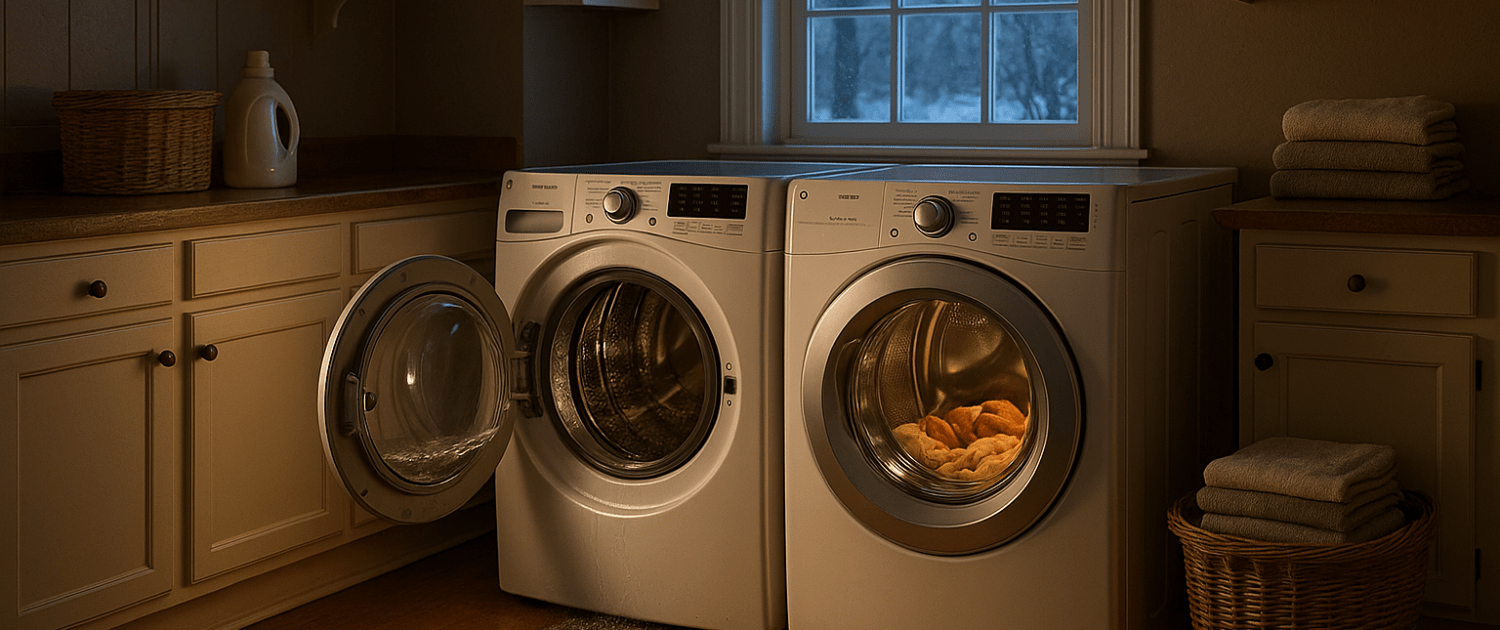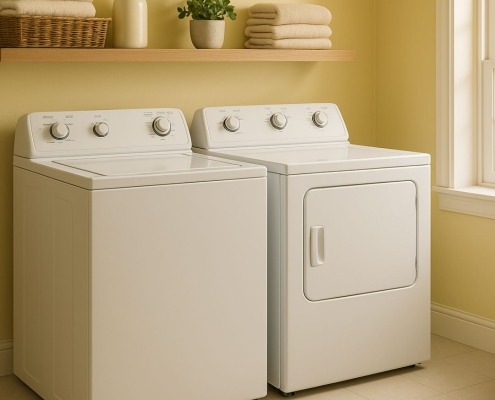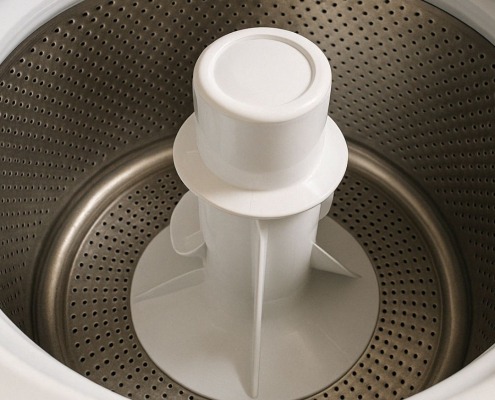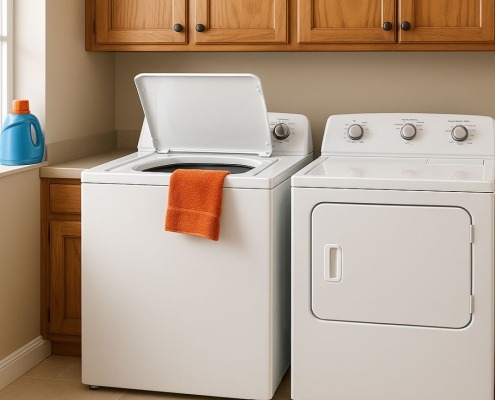How To Check And Replace the Drain Hose On An LG Washer
Steven E / Friday June 20, 2025
Leaky washer or water pooling where it shouldn’t? Your LG front-load washer’s drain hose might be the hidden troublemaker. When this essential part gets clogged, cracked, or worn out, it can lead to drainage issues and inefficient wash cycles. Whether you have a gas or electric model, we’ll share expert tips on testing and replacing the drain hose to get your washer back in top shape.
If you need any replacement parts for your LG front load washer, you can enter your model number at AppliancePartsPros.com to order them. Most orders arrive in just two business days, and we have thousands of free guides to show you how to install your new parts.
The information in this article may not apply to your specific appliance model. We recommend consulting your manufacturer’s documentation or contact us with any questions.
What you need
- Phillips screwdriver
- Adjustable pliers
- Towel
- Plastic container
- Flat blade screwdriver
Safety precautions
When working on any appliance, remember to keep safety first. Here are some tips to keep in mind:
- Always power off and unplug your appliance or switch off the circuit breaker before you attempt any maintenance or replacement work. This keeps you safe by eliminating any risk of electric shock.
- If the appliance has recently been used, give it plenty of time to cool down before working on it.
- Take your time while working to prevent accidents and personal injuries. Rushing is the enemy of precision.
- Work in a well-lit area so you can see and access appliance parts.
- Keep your workspace free of clutter and other obstacles. Keep children and pets away from the work area.
- Never work on internal parts with wet hands. Make sure the work area is completely dry.
- Check the user manual to see if there are specific installation or safety instructions related to your appliance or replacement part.
- Be gentle when handling or removing parts. Excessive force might damage the appliance or cause personal injury.
- Wear insulated work gloves to protect your hands from sharp metal parts and debris.
- When working with wires, avoid touching any exposed wires or terminals. If you need to touch a wire, use a non-conductive tool or wear insulating gloves to prevent electrical shock.
- Always take photos or make a note of wiring terminals or other connections before disconnecting them to make reassembly easier.
- Consider wearing safety glasses and/or a dust mask when working with chemicals, dust or a large amount of debris to prevent irritation or injury.
- Turn off the water supply at the outlet before beginning repairs. Keep towels ready to catch any residual water in the system when removing parts.
How to test and replace the LG front load washer’s drain hose
Here are the steps to inspect, test, remove, and replace the drain hose on your LG front load washer.
Step 1: Locate the drain hose
- Move behind the washer to find the drain hose, which connects the drain pump to the standpipe.
- Inspect the exposed section of the hose for cracks or leaks.
- If no visible damage is found, start the washer in a spin cycle to check for leaks.
- Identify the three main sections of the hose: behind the washer, inside from the pump to the top, and the top portion with the anti-siphon loop.
Step 2: Test the drain hose
- Check the exposed portion of the hose while the washer is draining.
- Bend the hose along its length to check for hidden cracks.
- If water leaks from any point, replace the hose.
- If no leaks are found externally, unplug the washer.
- Use a Phillips screwdriver to remove four screws securing the rear access panel, then slide it up and out.
- Remove two lower screws from the corner plastic brackets.
- Slide the top panel back slightly and lift it off to access the upper part of the hose.
- Plug the washer back in and start a spin and drain cycle.
- Use a flashlight to check the hose running along the right side at the bottom.
- If leaks are found, unplug the washer and prepare for removal.
- If no leaks are found, check the top portion of the hose.
- Do not touch anything while the washer is running.
Step 3: Remove the old drain hose
- Turn off the water supply by closing both faucets.
- Unplug the washer from the electrical outlet.
- Place a towel under the hoses to catch any water.
- Use pliers to unscrew both water inlet hoses and set them aside.
- Open the drain pump filter door by squeezing the hinges with a flathead screwdriver.
- Position a plastic container under the filter.
- Pull out the black drain hose, remove the plug, and drain the remaining water.
- Reinsert the plug and clip the hose back into place.
- Remove the pump filter, clean it, and reinstall it tightly.
- Tilt the washer onto its left side using a stable support.
- Locate the pump housing at the front right corner.
- Place a towel underneath to catch any water.
- Use pliers to squeeze the clamp on the black sump hose and slide it off.
- Slide the clamp up and detach the gray drain hose from the pump.
- Return the washer to an upright position.
- From the rear of the washer, release the drain hose from the retainer clip on the right side.
- Detach the hose from the wire retainer near the top.
- Pull the air-bleeding hose from the outer tub.
- Use a Phillips screwdriver to remove the single screw securing the drain hose bracket at the top right corner.
- Lift the drain hose out of its slots and push it through the retainer holder inside the washer.
- Pull the hose completely out from the back of the washer.
Step 4: Install the new drain hose
- Insert the long portion of the new drain hose into the cutout on the back panel.
- Slide the bracket into the slots.
- Secure the hose bracket with a Phillips screw from the back.
- Tilt the washer onto its side again.
- Attach the bent end of the hose to the drain pump port.
- Use pliers to squeeze the clamp and slide it down to hold the hose in place.
- Reattach the black sump hose and slide its clamp into position using pliers.
- Return the washer to an upright position.
- Follow the hose and clip it into the side retainer.
- Mount the hose into the wire clamp.
- Slide the air-bleeding hose onto the port on the outer tub.
Step 5: Reassemble and test the washer
- Place the top panel back onto the washer.
- Align it and slide it forward to lock it into place.
- Secure the top panel with two Phillips screws.
- Reconnect the water inlet hoses by hand, then tighten slightly with pliers without overtightening.
- Turn on the water faucets and check for leaks.
- Insert the drain hose into the standpipe.
- Plug the washer back in.
- Start a spin and drain cycle while checking for leaks.
- If no leaks are found, reinstall the rear access panel by inserting the top first and securing it with four Phillips screws.
Still need assistance?
Thanks for reading! We hope this guide helped you test and swap out the drain hose in your LG washer. If you still need a replacement part, just grab your model number and head to AppliancePartsPros.com, where we have over two million parts ready to ship. Most orders arrive in just two business days! For help tracking down the right part, give us a call at 1 (877) 477-7278. While you’re waiting, check out our DIY blog and explore our video tutorials on YouTube. Don’t forget to follow us on Facebook, X and Instagram for all the latest tips and repair guides!
With nearly a decade of experience in providing top-notch customer service regarding appliance parts and repair, Steven enjoys sharing practical advice, troubleshooting tips, and interesting information to help readers stay informed.





